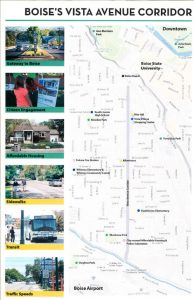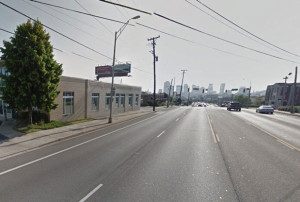Shifting the Focus of Commercial Strips from Moving Cars to Connecting People
Every American suburb has them. They feature fast-moving traffic, congested intersections, low density, and quite often lower-end real estate development. Pedestrians, cyclists, and transit riders cross them at their own risk.
Dotted by strip malls, fast-food outlets, and car dealerships, auto-oriented commercial corridors and suburban arterials are among the unhealthiest places in the built environment. They not only discourage active and sustainable modes of transport like walking, cycling, and mass transit, but many also bifurcate communities, isolating neighborhoods from one another and segregating land uses as well as people.
ULI’s Building Healthy Places Initiative and the ULI Rose Center for Public Leadership are taking a closer look at commercial strips and their potential to activate healthy behaviors in surrounding communities instead of inhibiting them. Through demonstration corridors in four geographically diverse and growing cities—Boise, Denver, Los Angeles, and Nashville—the healthy corridors project aims to spur real changes in infrastructure, policy, and programming along these sites. In addition, the project’s goal is to develop a typology, or model, of a holistically healthy corridor that can be replicated in communities throughout the world.
ULI Los Angeles, ULI Idaho, ULI Nashville, and ULI Colorado were selected through a competitive application process to participate in the project, supported by the Robert Wood Johnson Foundation and the Colorado Health Foundation.

Members from ULI Los Angeles, ULI Idaho, ULI Nashville, and ULI Colorado met in Houston to talk about the healthy corridors project.
At the 2015 ULI Spring Meeting in Houston, Institute members from these councils met together for the first time during a half-day forum, where they discussed the potential assets and present-day challenges of each demonstration site as well as of commercial corridors generally. Also providing insight were alumni from the ULI Rose Fellowship program, in which commercial corridors have surfaced as a major topic of concern for public and private sector leaders. In addition, a national working group of leaders in the fields of public health, transportation planning, real estate development, and urban design was on hand to offer feedback and will continue to advise the four groups representing the demonstration sites.
The first part of the forum was dedicated to identifying challenges and potential assets of corridors in general. Barriers to health were identified as the following:
- Volume and speed of traffic;
- Over-zoned for retail;
- Lack of sidewalks, bike lanes, and access to healthy food;
- Undesirable land uses like liquor stores, used-car lots, and adult entertainment;
- Entrenched and fragmented patterns of landownership;
- Working with state transportation departments, whose metric for success is often moving cars efficiently and quickly;
- Multiple jurisdictions with oversight of the corridor, resulting in fragmented leadership and vision;
- Lack of political or civic leadership on making corridors healthy places; and
- In general, conditions that were described as “dangerous, dirty, disconnected, and dismal.”
Participants also shared what they considered corridors’ latent or potential assets and opportunities to become the following:
- Sites for community-building, promoting local culture, gathering, and celebration;
- “Places” instead of merely a pipeline for cars through urban design strategies that emphasize public safety, visual appeal, and connectivity;
- “Complete streets,” or streets that accommodate multiple modes of transport—walking, cycling, automobiles, and transit; and
- Connector of residents to economic opportunities either as pathways to employment centers or as magnets for job creation and businesses.
In the second part of the forum, representatives from each district council presented an overview of their demonstration corridor.
ULI Idaho: Vista Avenue
Vista Avenue in Boise, Idaho, is a four-lane, four-mile (6.4 km) arterial road connecting Boise Airport to the downtown. A gateway to the city, Vista Avenue also acts a dividing line, separating the low-income Vista neighborhood from retail, public schools, and the rest of the city. Along with the municipal government of Boise, Boise State University, and other partners, ULI Idaho will be working on a 1.7-mile (2.7 km) stretch of the corridor that divides the Vista neighborhood. Several ULI Idaho members, including city councilman Ben Quintana, expressed a desire to make Boise the most walkable and livable city in the state.
“How do we make Vista Avenue not scary?” asked Quintana, part of the local leadership team.
Another one of Vista’s problem is no sense of place and a lack of branding, said Bob Taunton, ULI member and president of the Taunton Group. “It doesn’t have an identity. It’s the ‘street to the airport.’ ”
The Vista neighborhood is one of the first target areas of the city’s “Energize Our Neighborhoods” campaign, which takes a data-driven approach to bringing greater economic clout, safety, and improved services to low-income neighborhoods. Among the first steps in this campaign is the launch of pre-kindergarten to serve Vista’s families.
This partnership will be a key lever in bringing change to Vista Avenue since the city will be investing resources in and bringing attention to the surrounding neighborhood. Sustained engagement with residents will be a key metric of success for this project, according to Quintana and ULI member Ana Marie Guiles, Boise’s director of housing and community development. “We have to reach out to those neighborhoods and engage them first, and make sure they’re engaged the entire time,” Quintana said.
ULI Nashville: Charlotte Avenue
Charlotte Avenue is a four-mile (6.4 km) commercial corridor in Nashville that connects the city’s western suburbs to the state capitol downtown. ULI Nashville is focusing on a two-mile (3.2 km) stretch of the corridor close to downtown, skirted to the north by historically African American working-class neighborhoods and the historically black institutions of Fisk University and Tennessee State University (TSU) and flanked by the city’s Midtown neighborhood and medical district on the south.

Charlotte Avenue is a four-mile (6.4 km) commercial corridor in Nashville that connects the city’s western suburbs to the state capitol downtown.
ULI member Ryan Doyle, chair of the local ULI Nashville leadership team, praised Charlotte Avenue for its diversity of uses—from the highest-value Class A office space downtown to residential neighborhoods to the west. Doyle is general manager of OneC1TY, a new mixed-use, multibuilding campus focused on the life sciences, technology, and health care sectors, located to the south of Charlotte Avenue.
“We love the corridor because it has every type of development on it,” said ULI member Dana Neal, director of business development at Skanska’s Nashville’s office. Yet, opportunities exist for Charlotte Avenue to forge more of a connection to surrounding communities rather than simply functioning as a throughway for commuting downtown workers. And ULI Nashville members are optimistic that solutions for Charlotte Avenue could be applied to other corridors around town.
ULI Nashville’s greatest challenge may be in breaking down silos by bringing neighborhood groups together with the medical and universities communities, which could play a role in collecting health data and performing health impact assessments. In addition to Fisk and TSU, Nashville is home to several institutions of higher education, including Vanderbilt University and Lipscomb University. An upcoming mayoral and city council election also injects uncertainty into the equation.
ULI Denver: Federal Boulevard
ULI Colorado will be looking at a 2.5-mile (4 km) segment of Federal Boulevard near the Chaffee Park neighborhood and Regis University, where momentum is picking up around new developments like Urban Ventures’ Aria Denver on the site of a former convent. Currently dominated by low-end uses like used-car lots and fast-food restaurants, Federal Boulevard is surrounded by established neighborhoods that are quickly gentrifying to become hot real estate markets. ULI Colorado members of the local leadership team expressed concern about displacement of low-income residents.
“How do we not disenfranchise the people who are already there?” asked David Thorpe, vice president of Shaw Construction, and member of the local leadership team. Specific actions need to be taken to address pedestrian safety issues, though. Fewer than 50 percent of the blocks facing the corridor have sidewalks, and the study area has seen several pedestrian and cyclist deaths in recent year.
The good news for this project is that the Tri-County Health Department (Adams, Arapahoe, and Douglas) has conducted several health studies of the local population, which is largely Latino and middle-to-lower income.
ULI Los Angeles: Van Nuys Boulevard
Like ULI Idaho, ULI Los Angeles has a ready-made partner in the local government. The segment of Van Nuys Boulevard that the local leadership team is focusing on is also part of Mayor Eric Garcetti’s Great Streets Initiative.
The neighborhood through which this stretch runs is Pacoima, a largely Latino, working-class community. The community has had to deal with a host of environmental justice issues since the area has been a historic dumping ground for heavy industry, according to leadership chair Melani V. Smith, a principal at Meléndrez.
The surrounding neighborhoods consist of mostly single-family homes that are being used as multifamily dwellings with multiple families living under the same roof in sometimes hazardous living conditions. This stretch of Van Nuys is quite car-oriented and lacks bike and pedestrian infrastructure. There is a strong cultural bias toward automobiles in the Latino community, in which the car is a status symbol. Accordingly, the area has among the worst health profiles in the city, with high rates of diabetes and obesity.
The good news is that extensive health data on local residents have been collected and mapped in a “health atlas” maintained by the city government. And there is a strong tradition of public art in the form of murals and mom-and-pop businesses that cater to the Latino community.

Members from ULI Los Angeles, ULI Idaho, ULI Nashville, and ULI Colorado met in Houston to talk about the healthy corridors project.
Next Steps
Now that the teams representing the four demonstration corridors have convened and exchanged ideas, the hard work begins on identifying short- and long-term outcomes for each site. Each team is eager to demonstrate to local stakeholders a few “quick wins” and successes. Long-term change, though, will require sustained attention to and financial support of soft and hard infrastructure upgrades to each corridor.
This summer, each demonstration corridor will hold workshops to meet with local stakeholders—elected officials, planners, the local real estate community, and neighborhood groups. The four teams will meet again at a forum at the 2015 ULI Fall Meeting, and will organize study tours of their specific corridor by members of the National Working Group and Rose Alumni during the fall and winter.



